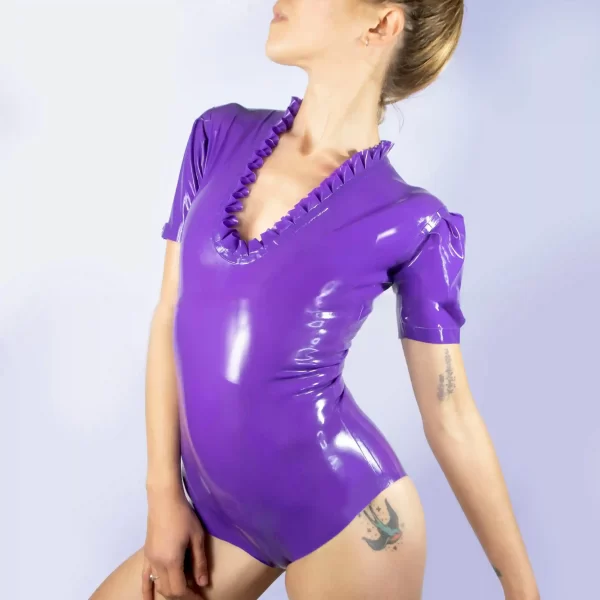
Latex clothing has continuously fascinated fashion devotees – it is theatrical, suggestive, and laden with symbolism. From haute-couture designs on the catwalks to fetish practices, latex garments transcend their functional purpose as clothing items and become symbols of desire, transgression, and identity. This survey of latex clothing unravels the cultural codes that underpin this now iconic material, investigating both its historical trajectories and its significance today.
Historical Origins and Evolution:
The first latex clothing pieces appeared in the early 20th century and were initially associated with the world of fetishism and avant-garde dressing. Clothing designed with latex material was adopted by various subcultures wishing to challenge social, sexual, and sartorial conventions. What it visually implied was rebellion, corruption, and freedom of the body. Fetish model Bettie Page and notable fetish photographer John Willie began to sport latex apparel or photograph women wearing it in the mid-20th century, promoting the association of latex with sexual and sub-cultural dissidence.
As we have seen, fashions change, and with time mainstream fashion became the perfect environment for latex clothing to reinvent itself. The material shed its former association with moral corruptness and sexual deviancy. Later in the 20th century, influential fashion designers such as Jean-Paul Gaultier and Thierry Mugler brought latex clothing to mainstream fashion by integrating it into their high-fashion collections. According to Andy Mauer, the head of fashion at the Art and History Museum, the interesting thing about the fashion exhibition is the way latex, a fetishistic field, is mixed with the world of couture, which previously perceived latex to be trivial. Here latex goes from being a super niche fetishistic commodity to being a field of art and a display of fashion.
Signification and Subcultural Identity:
Aside from its visual quality, latex fashion is also extremely iconic. It is well known for being a symbol of subculture identity, aspiration, and even sexual behavior and power in subcultures. It can hold more power in certain subcultures than in others, for example in the BDSM world latex marks out themes of dominance, submission, and eroticism whereas latex remains as a piece of equipment for self-definition and expression, offering a medium for the user to get in touch with segments of themselves through costume play. More broadly, in alternative fashion and club wear latex fashion, specifically high-style latex styles, serves as a canvas for a desire for rebellion against mainstream fashion images and societies. It’s worn by punks, goths, and other underground youth subcultures trying to break feminist standards and representatives from their mothers and fathers as well as from the public at large. Latex has continuously stood out against the societal norms of what’s proper and what’s not and what is or isn’t too tight to wear. In this sense latex’s tight, shiny, and form-flattering attributes present a summons for appreciation, or despise, from those who look upon them.
Artistic Performance and Expression:
Another play in which latex is utilized to express art and fiction is the realms of the performing arts and entertainment. There are latex wears that leave little to the imagination or that give just a hint of the person underneath. Latex clothes designers are limitless too. This material gives the wearer a certain power over the audience which is why it is so popular in theatrical performances, like burlesque and drag shows. It helps develop personas in the performers and sometimes, audience members forget the actual gender of the person underneath. Latex is also a favorite in movies and music videos, due to its powerful and magnetic look that symbolizes power and seduction. Lithe and supple, this material reveals only the curves of the body, giving an air of mystery and intrigue. With the thousands of latex clothing designers, you will surely find one or two that stand out from the rest. However, below are the most notable creators.
Contemporary Reinterpretations and Social:
Commentary While latex clothing was largely positioned as a “fetish wear” for sexual escapades at displaced social gatherings, it has resumed its popularity in recent years, through alternative fashion movements and body acceptance movements. Both designers and regular latex fans have embraced it as a form of pride expression and seek to challenge traditional gender and beauty stereotypes. Contemporary adaptation of latex garments arrives with an inclusive message.
Designers offer a broad spectrum of sizes, designs, and styles to cater to a diverse range of body shapes and lengths. In addition, latex pieces can also be used as platforms for social commentary and activism. Ongoing efforts from designers and artists aim to dispute social norms and demand changes in society. We have seen various body-positive campaigns through latex garments. Many artists and fashion designers through this trendy wear also advocate LGBTQ+ community rights. Not protecting or maintaining a liberal and free society but are a real testimony to the determinists living in it. Besides, by changing the perception of what latex clothing is and providing new ways of wearing it, makers are altering the story of its history and providing an alternative narrative.
Personal Identity and Empowerment:
Latex clothing is so much more than just a fashionable statement. It’s a medium of self-assertion and self-discovery. For many people, especially when it comes to gender identity, body positivity, and personal growth or transformation, wearing latex is an empowering way to take more control over their own body image. The tight, body-hugging fit of latex clothing allows it to function as a literal “second skin.” Many people experience a powerful boost in self-confidence from wearing latex, knowing they are projecting their own sense of strength and pride in a world that likes to stifle such acts.
Artistic Mediums and Cultural Production:
Many creators of various forms of art love to experiment with the world of latex. Designers, for example, love using latex to blur the lines of fashion, questioning the ethos of high fashion and offering fresh takes on themes such as the future, sex, and, quite often, dystopia. In the visual arts, latex appears as well, often in installations and sculptures because of the way it plays with both texture and light. It is a material that draws your fingers as much as your eyes and it creates works that call out to be both touched and seen. In film and photography, latex too adds a level of visual depth. It can suggest a way of assuming a liquid future or the decay into some post-apocalyptic world. It is a visual opposite to the natural world, but one that can also be used to heighten the allure of the human form in abstract and artistic ways. It is the different ways in which latex is used in engaging in different media that demonstrate its inventive use of material with a deep and symbolic history in the world of culture.



